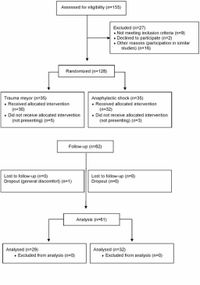A recent study conducted at the Advanced Clinical Simulation Center at Valladolid University in Spain highlights the correlation between anxiety levels and pupillary response among undergraduate medical students. The research, which took place from February 1 to April 15, 2023, involved 61 sixth-year medical students participating in high-fidelity simulations—specifically scenarios depicting major trauma and anaphylactic shock.
The primary aim was to explore how changes in pupillary diameter could serve as an indicator of anxiety, gauged by the State-Trait Anxiety Inventory (STAI). The STAI score—meanwhile known as the gold standard for assessing anxiety—recorded a notable increase post-simulation, with average scores rising from 56 to 66 points, reflecting a 17% change. Researchers noted this finding as significant, suggesting that heightened anxiety levels correlate with increases in pupillary size.
"The predictive model had an area under the curve (AUC) of 0.876, indicating a strong relationship between pupil diameter changes and anxiety levels," said the authors of the article. Specifically, the study recorded a pre-simulation median pupil size of 4.71 mm in the right eye, expanding to 5.69 mm following simulation. Similarly, the left eye exhibited an increase from 4.65 mm to 5.71 mm.
This relationship was particularly intriguing following the effects of the simulated clinical scenarios, which were designed to mimic real-life emergencies with unpredictable dynamics. Participants played through each scenario for a maximum of 10 minutes before undergoing post-simulation evaluations, which included reassessments of vital signs, emotional responses, and pupillary reactions.
The trial's design followed rigorous ethical guidelines, approved by the Ethics Committee for Research with Medicines of the Valladolid West Health Area. Volunteers were chosen based on specific inclusion criteria, while randomization ensured unbiased selection into scenario groups. Importantly, participants completed a pre-experimental questionnaire, assessing their demographic data and baseline anxiety levels measured by the STAI.
Besides the direct measures of anxiety through mental evaluation, the study also pointed out the importance of physiological responses. The researchers observed that pupillary response can reliably indicate emotional and cognitive processing concerns, serving as a window into the student’s psychological state during intense training exercises.
Findings from this research underscore the critical role of high-fidelity simulations in medicine education—particularly regarding their potential to evoke anxiety among students. The implications suggest that understanding individuals' varying anxiety thresholds could revolutionize preparatory modalities and improve training conditions within clinical settings.
This trial represents a ground-breaking step into understanding student mental health within simulated environments. High levels of anxiety are not merely detrimental; they can impede a student’s ability to make sound decisions during critical moments arising from stressful scenarios. Thus, the researchers propose integrating mechanisms like regular pupillometry alongside traditional psychological assessments to foster tailored educational methods.
Overall, the study emphasizes the need for healthcare educators to recognize and respond to heightened anxiety in medical students. “Increased awareness and a proactive approach in addressing students' anxiety levels can contribute to a more effective education model,” the authors of the article stated.
In summary, studying the intricate relationship between pupil size, anxiety, and clinical simulation could open avenues for refining training protocols. As simulations become central to medical training, insights from this research may help facilitate not only better education but also improved mental well-being for future healthcare professionals.

